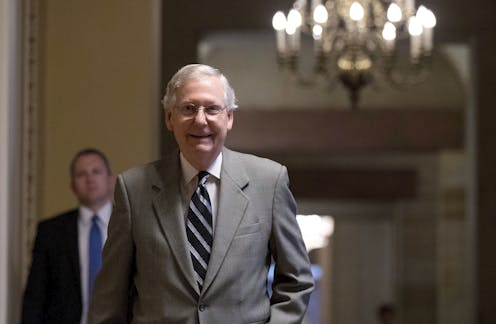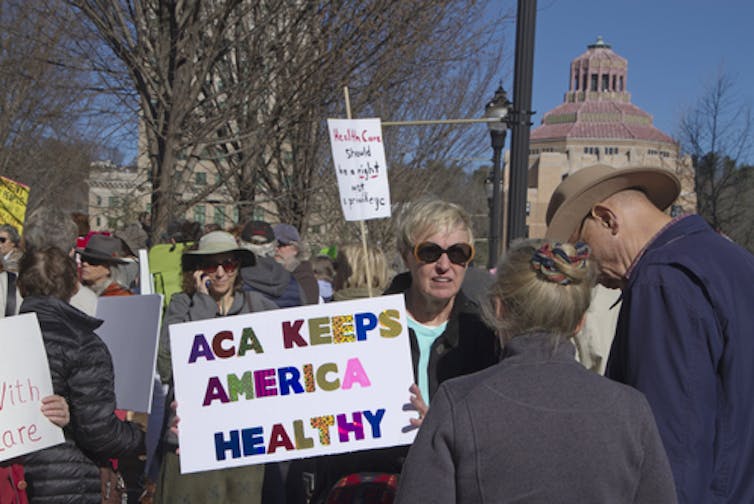US health care system: A patchwork that no one likes
Many Western, industrialized nations provide health insurance. The US has repeatedly balked at universal coverage. So what kind of system are we left with? A very unpopular one.

Almost all parties agree that the health care system in the U.S., which is responsible for about 17 percent of our GDP, is badly broken. Soaring costs, low quality, insurance reimbursements and co-payments confusing even to experts, and an ever-growing gap between rich and poor are just some of the problems.
And yet, this broken system reflects the country’s constitutional foundation and its political culture. At the very core of both is a strong suspicion of governmental intervention and a disdain for concentrated power, paired with an exaltation of individual liberty and personal responsibility.
Translating this ideology into a modern state is a complex endeavor that often leads to constructs that resemble creations envisioned by Rube Goldberg. Perhaps nowhere else is this more obvious as in the American health care system. The result has been the creation of an uncoordinated, often inefficient, patchwork of programs that does not cover everyone, is excessively costly and often provides low-quality care.
The conflicts of the past linger into the present, as seen in the dozens of Republican unsuccessful attempts to repeal and replace the Affordable Care Act, the Obama administration’s signature, if maligned, law.
More generally, ideologically, the country has failed to reach a consensus about the appropriate role of government in the provision of health care for its citizens. Politically, reforming any part of the health care system becomes a third rail. Yet practically, while often left unacknowledged, government involvement is ubiquitous. Indeed, over time, governments, at both the state and federal level, have come to influence every component of the American health care system.
A fragmented ‘system’
Governments have three major options to provide benefits. They can regulate the conduct of private entities, provide services directly or merely provide financing while having services provided by other entities. In the United States, state and federal governments rely on all three options.
Today, half of all Americans obtain their insurance through an employer. Depending on the nature of the arrangement, these are subject to an often complex web of state and federal regulations.
However, over time, the federal government has taken on an ever-larger role in the regulation of insurance, most recently culminating with the passage of the Affordable Care Act in 2010. The federal government also provides generous tax incentives to encourage the employer-sponsored provision of insurance at an annual cost exceeding US$260 billion.
Yet, even despite regulatory action and financial support, more than half of all Americans are not covered through employer-sponsored insurance, thus requiring other, more active forms of government involvement.
Different plans for the old, the poor and veterans
Elderly Americans and some of those afflicted with disabilities and end-stage renal disease, about 14 percent of the population, are covered by a purely federal, social insurance, single-payer arrangement, Medicare.
Antiquated in its design because it separates hospital coverage from physician coverage, all working-age Americans are required to pay into the system that entitles them to hospital insurance at age 65. Voluntary physician and prescription drug coverage are subject to a combination of individual premiums and government subsidies. Many elderly choose to buy additional insurance protection to make up for the often limited benefits under these programs. Alternatively, eligible individuals can choose to obtain comprehensive coverage through private insurers in a program called Medicare Advantage.
Coverage for the poor and near-poor has been established through a joint state-federal program called Medicaid, providing coverage for almost 20 percent of Americans. Lacking the constitutional power to force states into action, the federal government necessarily seeks to entice states into cooperation by shouldering a majority of the cost and allowing states broad authority in structuring their individual programs. As a result, programs vary significantly across the states in terms of who is eligible and what benefits they have access to.

One peculiar exception is the way America provides health care to its veterans. Inherently ironic, in an arrangement that can only be described as socialistic, America’s veterans are able to obtain access to comprehensive services, often at no cost, through a national network of clinics and hospitals fully owned and operated by the federal government. Similar arrangements are in place for Native Americans.
Those left out of the various, decidedly limited, arrangements are left to seek coverage on their own from private insurers. Indeed, with the insurance market reforms and financial support of the ACA, today about 7 percent of Americans are able to purchase insurance privately, while 9 percent remain uninsured. Another patchwork of programs seeks to provide decidedly limited benefits to these individuals including through emergency rooms, government-supported private community health centers and hundreds of clinics and hospitals owned by cities, counties, states and state-university systems.
Has the ACA changed anything?

When the ACA was passed in 2010, supporters hailed it for moving the United States in line with its industrialized peers. Detractors demonized it by saying it was the final step toward socialism in America.
Neither side was correct in its assessment.
Within the American system, particularly as it has been used to expand access to health care, the ACA was a very substantial, but nonetheless natural, continuation of a long series of incremental, trial-and-error adjustments to new circumstances hailing back to the early 1900s. For the most part, the ACA perpetuates a system patched together from various private and public components by merely pairing some, albeit important, insurance market reforms with additional funding.
With regard to Medicaid, it simply added more, mostly federal, funding to bring more individuals into the program. For those buying insurance on their own, it facilitated purchasing insurance by establishing online marketplaces and by providing funding for lower-income individuals in the form of subsidies for premiums and out-of-pocket costs. Most importantly, it initiates meaningful insurance market reforms intended to facilitate access including the requirement to provide insurance regardless of preexisting conditions, by limiting how much consumer could be charged based on gender and age, and by requiring a minimum amount of services included, among others.
Yet even if the ACA were to be fully implemented, millions of Americans will be left without insurance, and the thorny issues of quality and costs will largely be left untouched.
The future is…uncertain
The American health care system is a complex amalgam. Evolving over time, we can see incremental, haphazard adjustments to changing circumstances over time, without much rationality or overarching forethought.
Conceptually, one can easily imagine a simpler approach. For example, the U.S. could adopt a single-payer system similar to those in many other wealthy industrialized countries. Practically, however, limited national authority, stark ideological divisions over the appropriate role of the national government in the provision of health care, and the creation of vested interests make other than a continued evolutionary approach politically unlikely, if not wholly implausible.
In such a system, exploiting the shortcomings of the American health care system and blaming it on the other party becomes a political imperative. No one party alone can truly reform the system by itself without risking the wrath of the electorate. Indeed, no underlying ideological consensus even exists about what kind of health care system the United States should have.
Under these conditions, neither party has much incentive to cooperate to initiate the meaningful reforms necessary to improve quality, access and costs. Thus, we are left with a system that is excessively costly and often of inferior quality that denies millions of American from accessing adequate care.
Simon Haeder does not work for, consult, own shares in or receive funding from any company or organization that would benefit from this article, and has disclosed no relevant affiliations beyond their academic appointment.
Read These Next
How Maduro’s capture went down – a military strategist explains what goes into a successful special
Months of preparation and intelligence gathering went into the mission to seize Venezuela’s president…
5 scenarios for a post-Maduro Venezuela — and what they could signal to the wider region
President Donald Trump has said the US will ‘run’ Venezuela until a ‘safe, proper and judicious…
West Coast levee failures show growing risks from America’s aging flood defenses
Levees protect more than 7 million buildings in the US today, yet they got a D-plus grade in 2025. A…






